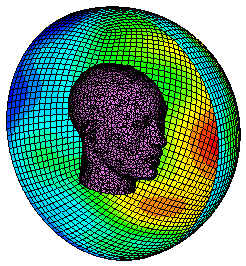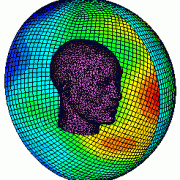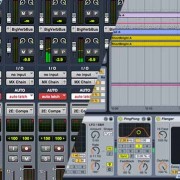What is HRTF? (Brief explanation)
Let’s get to know psychoacoustics.
HRTF stands for Head Related Transfer Function.
In other words: the phase and frequency response of our head. In fact, a transfer function is a particular mathematical formula that groups both data sets.
Basically, it is the way in which our head changes the sounds that reach our eardrums.
These changes are dictated by the structure of our head: nose, forehead, mouth, hair, bone density, auricles… every feature of us that the sound hits before reaching our eardrums. And, in the event that the sound is coming from below, our shoulders too.
Every struck “obstacle” is going to faintly change the sound, altering frequencies and phases.
Depending on where the sound comes from (in front, behind, above, below), is going to encounter different obstacles. And different acoustic alterations.
Our brain has finely memorized these peculiarities, and it takes advantage of them to understand which direction the sound is coming from.
That is the reason for which, even with our eyes closed, we can still understand the position of a sound source.
The organ that influences these alterations the most is auricles: all their twists are needed to extensively characterize the auditory changes, by having the latter “clash” onto them.
(You’ve finally understood why ears have such a “weird” shape, instead of simply being flat.)
Here’s an example of front (continuous line) and back (dotted line) HRTF.
If we apply the continuous line frequency response to a signal, our brain will understand that the source of the sound is in front of us.
If we apply the dotted line frequency response to a signal, our brain will understand that the source of the sound is behind us.
Needless to say that everyone of us has it’s own physical structure, and for this reason the HRTFs are never going to be identical. However, there’s a slight resemblance between all the HRTFs that allows our brain to effectively interpret signals that have been elaborated with other people’s HRTFs.
Moreover, are you aware that there are systems to record in HRTF, so that our recording isn’t just going to identify left and right (monodimensional), but also above, below and to the sides (tridimensional or binaural)?
Here’s one of the most common ones: a dummy head.
Dummy head (Neumann KU100)
That is, a tool that simulates the shape of a human head, with microphones instead of eardrums. The attempt is to effectively record the HRTF information.
And it works pretty well: listening to a recording made with this tool feels like being on stage.
Software-wise, there are HRTF decoders that allow HRFT data to be linked to a signal, therefore giving it 3D spatiality.
Another interesting implementation of HRTF is to be found in almost every modern headphones: to try and avoid the “sound inside the head” effect, a frontal HRFT impression is imprinted into the headphones.
Which is also the reason that headphones frequency responses can’t be interpreted “with the naked eye”.
By the way, here’s another example of a professional pair of headphones.
http://www.headphone.com/
Even if the curve is quite irregular, the auditory result is going to be reliable anyway, given that the anomalies are due to a particular frontal HRTF impression.
Actually. not exactly frontal, since the typical position of two speakers is a the vertexes of an equilateral triangle, with our head corresponding to the third vertex.
If you want to know why this tutorial was made, you’ll find out more in this post:
And you got our entire website to hear if we’re talking about something that we can do.
We want to hear about you!
If you found this post useful, please: share your experience with us on our social pages!
Maybe together with a link to what you’ve created, and using our official hashtag #lmkmprod to let us find you all.
We’re looking forward to hear about you!










Thank you for sharing your precious knowledge. Just the right information I needed. By the way, check out my website at Webemail24 about Accounting.
You’ve written terrific content on this topic, which goes to show how knowledgable you are on this subject. I happen to cover about Senior Health on my personal blog Seoranko and would appreciate some feedback. Thank you and keep posting good stuff!
I am genuinely thankful to the owner of this website for sharing his brilliant ideas. I can see how much you’ve helped everybody who comes across your page. By the way, here is my webpage ArticleHome about SEO.
I like how well-written and informative your content is. You have actually given us, your readers, brilliant information and not just filled up your blog with flowery texts like many blogs today do. If you visit my website Autoprofi about Auto Export, I’m sure you can also find something for yourself.
Great post! I learned something new and interesting, which I also happen to cover on my blog. It would be great to get some feedback from those who share the same interest about Professional Moving Services, here is my website Articlecity Thank you!
My site Articleworld covers a lot of topics about Blogging and I thought we could greatly benefit from each other. Awesome posts by the way!
Hurray, this is just the right information that I needed. You make me want to learn more! Stop by my page Article Sphere about Electricity/Electricians.
Bookmarked, so I can continuously check on new posts! If you need some details about Video Streaming Services, you might want to take a look at Article Star Keep on posting!